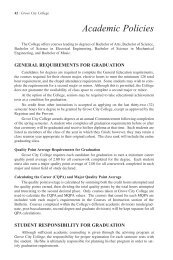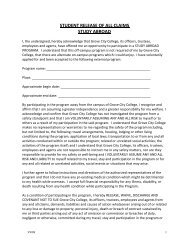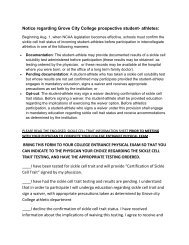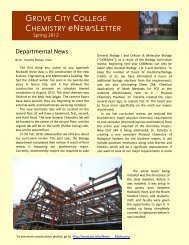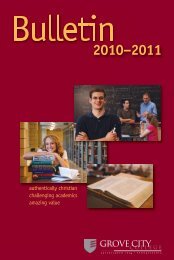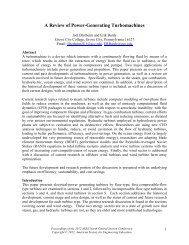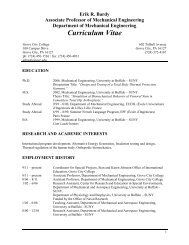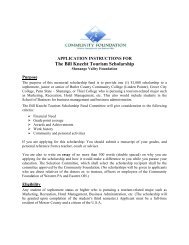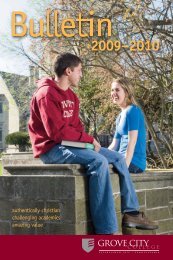dr. kevin shaw - Grove City College
dr. kevin shaw - Grove City College
dr. kevin shaw - Grove City College
Create successful ePaper yourself
Turn your PDF publications into a flip-book with our unique Google optimized e-Paper software.
GROVE CITY COLLEGE<br />
DEPARTMENT OF CHEMISTRY<br />
FROM THE DESK OF DR. TIMOTHY HOMAN, CHAIR<br />
Retirement News:<br />
Dr. David Jones retired in May of 2008. He taught<br />
Biochemistry in the department for 18 years and served<br />
as the department chairman for 15 years.<br />
Faculty News:<br />
Dr. Kevin Shaw is now teaching Biochemistry with a joint<br />
appointment in the Chemistry and Biology Departments.<br />
(You can learn more about Dr. Shaw’s research in the<br />
research spotlight in this newsletter.)<br />
Curriculum Review:<br />
The department completed a curriculum review last fall<br />
and will be implementing a number of changes in the<br />
curriculum this year. The department continues to be<br />
committed to a rigorous curriculum. Using several<br />
benchmark institutions and the new ACS undergraduate<br />
guidelines, we have retooled the curriculum, allowing<br />
students greater flexibility in choosing upper level elective<br />
courses. Two electives that were recently added are<br />
courses in computational chemistry and advanced<br />
instrumental analysis. See our new website for details.<br />
Other News:<br />
The department has continued to expand and upgrade its<br />
instrumental capabilities. The department now houses a<br />
60 MHz teaching NMR, a 300 MHz NMR, two FT-IR and<br />
four UV-VIS spectrometers, an AA, GC, GC-MS, HPLC,<br />
LC-MS, TGA and DSC. These instruments continue to be<br />
integrated into the curriculum as well as support<br />
faculty/student research projects. The <strong>College</strong>, through<br />
the Swezey Fund, has provided financial support for<br />
students and faculty to conduct research in the<br />
department during the past two summers. Three students<br />
participated in the program in 2009 and two more in 2010<br />
under the direction of Dr. Charles Kriley.<br />
With a generous bequest from the estate of Kent S.<br />
Dennis (Class of 1950), the Chemistry department<br />
purchased a new Anasazi Instruments 60 MHz FTNMR<br />
which will used in the organic chemistry laboratory. A<br />
Rigaku XtaLABmini bench top x-ray diffractometer (the<br />
first of its kind in North America) has been installed and<br />
will be used to determine structures of molecules<br />
synthesized in GCC research labs and in a soon to be<br />
offered crystallography elective course.<br />
2010 GRADUATING CLASS<br />
SEE UPDATES AT BOTTOM OF PAGE 5<br />
COMING HOME<br />
SEE OUR NEW WEBPAGE: www2.gcc.edu/dept/chem<br />
SEPTEMBER 2010<br />
FOR HOMECOMING?<br />
If you’re planning to attend Homecoming 2010,<br />
we’d enjoy the opportunity to catch up with you<br />
at the Chemistry department breakfast. This<br />
event is shared with the Biology department,<br />
so plan on seeing some familiar faces of<br />
former classmates and professors. Come<br />
share a continental breakfast anytime between<br />
9:00 and 10:30 AM in the first floor hallway of<br />
beloved Rockwell Hall, and then go enjoy the<br />
parade.<br />
In addition to the breakfast, feel free to ask for<br />
a tour of our updated instrumentation lab (lots<br />
of great new additions to our labs).<br />
Finally, come prepared to share your ideas for<br />
improving our department. After all, you’re the<br />
experts on being GCC students and alumni.<br />
Hope to see you on Saturday, October 9 th !
ERLENMEYER TO EINSTEIN: International Education Experience 2010<br />
CHEM 390 “The History of Chemistry”<br />
and SCIC 203 “Baby Chemistry” (the chemistry class provided for non-science<br />
majors to complete their lab science requirement)<br />
Nine students traveled to Germany this past May<br />
Intersession for two weeks (5 for SCIC 203 and 4 for CHEM<br />
390). Both classes spent time during the spring semester<br />
preparing for the trip by completing about ½ of the class<br />
material on the GCC Campus. The students were then<br />
ready to head to Germany by way of Amsterdam. Along<br />
with the students were two alumni and Dr. Kriley.<br />
The SCIC 203 students were given lectures in both the<br />
youth hostels and trains, taking quizzes along the way.<br />
Laboratories were handled in a unique way; traditional labs<br />
were performed at <strong>Grove</strong> <strong>City</strong> <strong>College</strong> and oversea labs<br />
consisted of visiting a chocolate factory in Köln, the<br />
Deutsche Science museum in Munich and, yes, even the<br />
Heineken plant in Amsterdam (perhaps the most modern<br />
and instructional tour of the three).<br />
Students, faculty and alumni stayed in various youth<br />
hostels during the two week trip, providing the students with<br />
close interaction with a variety of different cultures. Next to<br />
the Berlin hostel was a three day intercultural fair which the<br />
students attended on two different nights, absorbing not<br />
only the German culture but a variety of other countries as<br />
well. Some of the other highlights of the trip were a Fat Tire<br />
Bike Tour in Berlin, a stay in Rothenberg (one of the few<br />
remaining walled in cities in Germany), a trip to<br />
Neuschwanstein and a day at Dachau, one of the first<br />
concentration camps in Germany. The trip included a<br />
multitude of cities including Amsterdam, Hamburg, Berlin,<br />
Munich, Rothenberg, Frankfort and Köln as well as a 4 hour<br />
Rhine cruise.<br />
The CHEM 390 students were required to write and<br />
present two papers, one on a German scientist and the<br />
other on the top ten scientific discoveries that have<br />
happened in their lifetime. These students were also<br />
required and tested on reading “Uncle Tungsten” by Oliver<br />
Sacks (a great book to read if you are interested in the<br />
development of science during the 18 th and 19 th century). It<br />
was a great trip which will hopefully be repeated in the next<br />
couple of years. Next year another group of students will<br />
be going to Nantes, France, for a similar trip during the May<br />
intersession 2011.<br />
Dr. Chuck Kriley (class of ‘88 and<br />
Professor of Chemistry at GCC)<br />
Students take an historical tour of Berlin.<br />
Doner Kebab: the Traveler’s Choice
ALUMNI INFORMATION<br />
COLLIN MOORE (‘93) SHARES BUSINESS EXPERTISE WITH GCC STUDENTS…<br />
SHARE YOUR UPDATES WITH US…<br />
We believe that our alumni community has a<br />
wealth of wisdom, insight, and experience to<br />
share with our current and prospective<br />
students. We’ve designed an on-line survey to<br />
start tapping into this wonderful resource.<br />
Please click on the link below and take a few<br />
minutes to answer the questions in our<br />
survey. The questions focus on <strong>dr</strong>awing out<br />
your experiences, reflections, and perspective<br />
on your career, your college experience and<br />
your advice for our students. It should only<br />
take a few minutes and, with your permission,<br />
we will incorporate your insights in the alumni<br />
section of our departmental website and in<br />
departmental planning and instruction. Just<br />
click on the link below and join in building our<br />
community knowledge base.<br />
http://www.surveymonkey.com/s/6CJYWK2<br />
NOTE: If you do not wish to share your<br />
information in future publications, simply<br />
indicate so at the end of the survey.<br />
We are pleased to share the following interview with<br />
Collin and want to express our thanks to him for his<br />
ongoing contributions to the Chemistry department.<br />
Q: Please share reflections or recollections of<br />
your experience at GCC and explain how this has<br />
impacted your life & career.<br />
CM: The most basic and straightforward answer to<br />
this question, is the solid, fundamental, education<br />
GCC provided. This is true of both the chemistry<br />
education I received (I felt prepared for whatever<br />
branch of Chemistry I wanted to pursue), and also in<br />
the solid, Liberal Arts background. Outside of science,<br />
I have truly cherished the rounded curriculum. You<br />
meet people with varying experiences and<br />
backgrounds during your career. Thanks to the core<br />
curriculum, I had a broad enough background to find<br />
common ground with everyone with whom I have had<br />
to work. Since you meet people from all different<br />
cultures, religions and value systems, the solid<br />
grounding provided by GCC is a huge benefit. In the<br />
end, it is not always the smartest or even the hardest<br />
working person who gets the most done. It is often the<br />
person who is best at interacting with people and<br />
convincing them to follow a vision that is the most<br />
productive. Also, being a Beta Sigma really helped<br />
keep my feet on the ground.<br />
Q: Please share a bit about your perspective on<br />
the future and what skills our students might need<br />
to develop in order to contribute to their chosen<br />
career paths.<br />
CM: We in the chemical industry face an ever<br />
increasing pressure from the new Global<br />
economy. I would say that the ease of<br />
information exchange and travel have made the<br />
world a very small place. This began with<br />
manufacturing, but quickly moved to technical<br />
service and computer industries.<br />
(interview continued on page 4)
ALUMNI INFORMATION (cont’d)<br />
Interview with Collin Moore (cont’d)<br />
I am aware of two paint companies who have moved entire labs to India, where a salary for PhD’s is only about<br />
$15,000. This, I believe, is only the beginning. Things like digital X-rays make cheap diagnoses from highly qualified<br />
doctors in India fast and cheap. This trend will continue. For the best chance of success in today’s economy, I<br />
believe graduates must become globally aware. Technical expertise is soon to be the entry level qualification for a<br />
job. For a career, the ability to function in a global economy is absolutely essential. My advice? Learn all you can<br />
about different cultures. A misunderstanding due to ignorance can ruin a relationship, but a good understanding of a<br />
culture can advance your relationship very quickly. Learn another language, maybe two. Lastly, our graduates can<br />
no longer be simply good. They must be the best when facing talented people from all over the world. This trend<br />
must be viewed as an opportunity for those who are willing to seize it.<br />
In March 2010, Collin & a colleague from BASF visited campus to present a seminar & lead Chem 406 (Instrumental<br />
Analysis) students in an experimental design project. Here, Collin shares his reflections on this collaborative project:<br />
I have always had a great desire to give back to <strong>Grove</strong> <strong>City</strong> <strong>College</strong>. As a parent of four in a single income<br />
household, however, my financial resources are limited. That said, one day it occurred to me that there<br />
was one way I could give back, and this was in the area of sharing what I have learned in my industrial<br />
career. I contacted Dr. Homan and shared some of my ideas. With the fluid grace of a highly experienced<br />
manager, he said, “Sure, how about you help with that?”. (I had just been out-managed by a professor,<br />
although he may have been helped along by the fact that I thought a collaborative project sounded like a lot<br />
of fun.) Dr. Homan put me in touch with Dr. Mike Falcetta and an exciting collaboration began. Initially, it<br />
started as a suggestion about incorporating experimental design into the curriculum so that the students<br />
could have a taste of the technique, and ended up evolving into a short course on “life in the big city”. Dr.<br />
Falcetta found a clever problem that the bio department was wrestling with and tasked his Senior class with<br />
solving the problem.<br />
It began with a literature search, followed by a visit to GCC where my colleague & I observed the students’<br />
oral reports and discussed the potential solutions they found during their investigation. It was our goal to<br />
help them think about the work that was done, rather than simply regurgitate their readings. We treated<br />
them like researchers in an industrial setting and expected them to be our company experts. Lest you<br />
judge us too harshly, you should know we were very gentle. Over the next few weeks, they labored<br />
furiously on the topic, incorporating experimental design into their work. In the end, they delivered a<br />
procedure for the freshman BIO class. They were expected to provide the team with regular updates,<br />
based on a predetermined set of milestones. We felt this was the best way to give them a “practice run” of<br />
what they may soon be facing. I can only imagine how crabby they were at first, but in the long run, they all<br />
told Dr. Falcetta how great an experience it was and that we should do it again for another class. It was<br />
only at the end that Dr. Falcetta let them know what we were trying to do. When they began to understand<br />
what was expected of them, they rose to the challenge and that was extremely rewarding. GCC faculty<br />
greatly desire to prepare their students for what lies ahead.<br />
*******************************************************<br />
ATTENTION ALUMNI! SEND US YOUR PHOTOS FOR OUR NEW CHEMISTRY DEPARTMENT WEBSITE…<br />
We would like to have pictures of our alumni in the alumni section of our new website.<br />
As a visitor navigates to that webpage, they would see pictures of alumni which would change every few seconds.<br />
If you’re willing to be part of the slide show, send an electronic photo via e‐mail to mffalcetta@gcc.edu.<br />
Just remember that anyone who visits the website can see the photo, not just GCC alumni.<br />
Thanks for helping to build our website!
DR. KEVIN SHAW (‘95) CONTINUES RESEARCH<br />
INTO 4r PROTEIN STRUCTURE<br />
The central dogma of molecular biology describes the flow of genetic information from genes to proteins.<br />
An expanded view of the central dogma is illustrated above with the “rules” for each transformation<br />
included. Our research focus is to contribute to the understanding of the less well understood rules which<br />
govern protein folding (“?”). One of the major open questions of protein folding is “can a threedimensional<br />
structure be predicted given only a polypeptide sequence?” The current state-of-the-art<br />
methods for answering this question are displayed every two years at the CASP meetings (Critical<br />
Assessment of Structure Prediction, http://predictioncenter.org/) where predictions are made for several<br />
newly solved but yet unpublished protein structures. We would like to develop de novo prediction<br />
methods (those which do not use sequence homology modeling or meta-predictions, combinations of<br />
published prediction methods) in order to participate in these meetings. The data for the development of<br />
these methods come from a wealth of experimental studies with proteins in test tubes as well as statistical<br />
surveys of known protein structures, many dating back to the late 1960s.<br />
We are, as a first step, looking at some of the classic surveys of protein structure. The first area in<br />
which we have learned something is the conformational preferences of the amino acids, particularly the<br />
tendency to form an α helix, helix propensity. The first statistical description of conformational preferences<br />
was made in 1974 (and is still the classic reference) using 15 proteins containing 2,473 residues. At the<br />
time, these were all of the non-homologous protein structures known. Today, however, if you look through<br />
the 66,324 structures currently in the protein data bank (http://www.rcsb.org/, as of early July, 2010), you<br />
find several thousand non-homologous structures, a much larger sampling size. Using this observation,<br />
we assigned secondary structures to a large group of structures (3,978 proteins, 559,075 residues) using<br />
standard methods and calculated all of the statistical parameters. We write our code in Perl, and the<br />
complete calculation takes less than ten minutes. The results for the larger data set are not <strong>dr</strong>amatically<br />
different, but the subtle differences become apparent when compared to experimental measures of helix<br />
propensity.<br />
In the 1980s, the helix propensity for each of the twenty amino acids was measured in synthetic<br />
peptides, and in the early 1990s, with the development of PCR methods for site-directed mutagenesis,<br />
they were also measured in several protein models. If all the experimental scales (more than twelve) are<br />
taken together to form a unified scale, the classic data show a moderate correlation (R=0.78) and only<br />
capture approximately seventy-five percent of the energy range. However, our scale correlates much<br />
better with the experimental data (R=0.88), and the encapsulated energy range (0.00-0.95 kcal/mol).<br />
Class of 2010 Post Graduation Plans:<br />
David Earl: Pursuing a Ph. D. in the Chemical and Physical Biology Program at Vanderbilt University<br />
Cerise Fereshetian: Quality control, Estee Lauder<br />
Tom Lilly: Pursuing a position as chemistry, secondary education teacher<br />
Elizabeth Michael: Pursuing a Ph. D. in the Energy Engineering Program at Penn State<br />
Charles Neff: Pursuing a position as chemistry, secondary education teacher<br />
Doug Pichler: Attending pharmacy school at The University of Pittsburgh<br />
An<strong>dr</strong>ew Scharf: Pursuing further education in the health care field<br />
Laura Seavy: Pursuing a Master of Science in Physician Assistant Studies at Marietta <strong>College</strong><br />
Nancy Stabley: Working for Americorps in the “Change a Heart: Franciscan Volunteer program”; applying to medical school<br />
Katherine Watkins: Pursuing a Ph. D. in the Chemistry Department at Vanderbilt University




